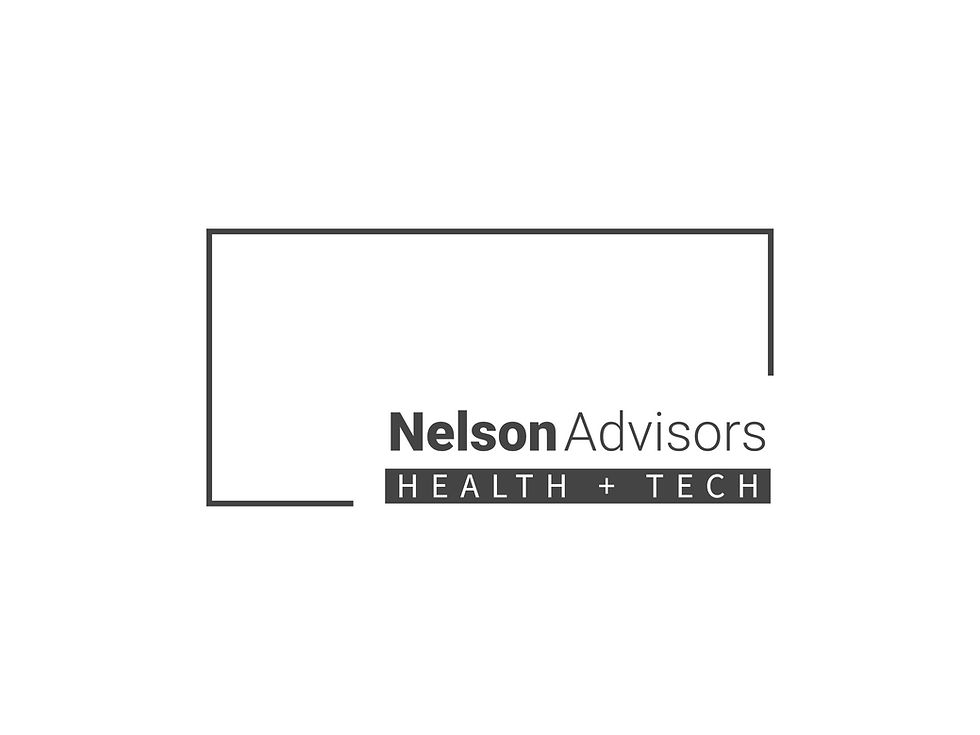HealthTech M&A multiples: September 2024
- Lloyd Price
- Sep 24, 2024
- 7 min read

Exec Summary:
As of September 2024, HealthTech M&A valuation multiples have shown a trend towards moderation.
This is largely due to a combination of factors, including:
Economic conditions: The broader economic environment, including interest rates and market sentiment, has influenced investor appetite for risk.
Regulatory changes: Shifts in healthcare regulations, such as those related to reimbursement and data privacy, have impacted the valuation of certain HealthTech companies.
Increased competition: The growing number of players in the HealthTech space has intensified competition, potentially leading to lower valuations.
While specific multiples can vary widely based on factors like company stage, growth prospects, and market position, here are some general trends:
Enterprise value (EV) to sales multiples: These multiples have generally decreased from their peak levels, reflecting a more cautious approach from investors.
EV to EBITDA multiples: While still relatively high, these multiples have also seen some moderation, particularly for companies with lower growth prospects.
Average multiples in HealthTech sub markets
The average revenue multiple for HealthTech companies in September 2024 is 4.25x ARR.
The average revenue multiples for different types of HealthTech companies in 2024 are:
Telehealth companies: 5.1x to 4.4x
Wellness companies: 3.7x to 3.1x
Drug discovery companies: 7.2x to 5.6x
Medical device companies: 4.7x to 4.0x
Healthcare IT companies: 3.75x to 2.25x
As you can see, drug discovery companies tend to have the highest average revenue multiples, reflecting the high-risk, high-reward nature of the sector. Telehealth and medical device companies also command relatively high valuations due to their significant growth potential. Wellness and healthcare IT companies typically have lower multiples, but this can vary depending on their specific niche and business model.
The HealthTech M&A market has segmented into three primary categories:
High-Quality Companies: These companies, characterised by strong financial performance (revenue, growth, and profitability), are highly valued and often command premium valuations. Their low-risk profile, ability to scale and maintain market share, and the scarcity of such opportunities contribute to their attractiveness.
Medium-Quality Companies: These companies face challenges in finding buyers at their desired valuations. Their operating losses and the high standards set by high-quality companies create a valuation mismatch.
Distressed Companies: These companies struggle to justify their valuations to potential buyers. Their perceived risk profile is only seen as worthwhile at a significantly discounted price. It's estimated that 25% to 35% of UK M&A deals involve distressed companies selling for less than their total capital investment.
10 Key Variables in HealthTech M&A valuation multiples today are:
Stage of the company's development: Early-stage companies are typically valued at a lower multiple than more mature companies.
Size of the company: Larger companies are typically valued at a higher multiple than smaller companies.
Intellectual property portfolio: Companies with valuable intellectual property are typically valued at a higher multiple.
Quality of the management team: A strong management team can add value to a company and may lead to a higher valuation.
Revenue growth: This is one of the most important factors in determining the valuation of a healthtech company. Companies with strong revenue growth are typically valued at a premium to those with slower growth.
Gross margin: Gross margin is a measure of a company's profitability. Companies with higher gross margins are typically valued at a premium to those with lower margins.
Customer acquisition costs: Customer acquisition costs (CAC) are the costs associated with acquiring new customers. Companies with lower CACs are typically valued at a premium to those with higher CACs.
Market share: Market share is a measure of a company's dominance in its industry. Companies with a large market share are typically valued at a premium to those with a smaller market share.
Regulatory landscape: The regulatory landscape for healthtech is constantly evolving. Companies that operate in industries with a favourable regulatory environment are typically valued at a premium to those that operate in industries with a more challenging regulatory environment.
Technology moat: A technology moat is a competitive advantage that makes it difficult for other companies to compete with a company. Companies with a strong technology moat are typically valued at a premium to those that do not have a moat.
Nelson Advisors work with Founders, Owners and Investors to assess whether they should 'Build, Buy, Partner or Sell' in order to maximise shareholder value.
Healthcare Technology Thought Leadership from Nelson Advisors – Market Insights, Analysis & Predictions. Visit https://www.healthcare.digital
HealthTech Corporate Development - Buy Side, Sell Side, Growth & Strategy services for Founders, Owners and Investors. Email lloyd@nelsonadvisors.co.uk
HealthTech M&A Newsletter from Nelson Advisors - HealthTech, Health IT, Digital Health Insights and Analysis. Subscribe Today! https://lnkd.in/e5hTp_xb
HealthTech Corporate Development and M&A - Buy Side, Sell Side, Growth & Strategy services for companies in Europe, Middle East and Africa. Visit www.nelsonadvisors.co.uk

HealthTech M&A valuation multiples
HealthTech M&A valuation multiples are a set of metrics used to determine the value of a HealthTech company in an acquisition or merger.
These multiples are typically based on financial metrics such as revenue, earnings, or users/subscribers, and can differ based on the company's stage of development, growth prospects, market position, and other relevant factors.
Some of the most commonly used HealthTech M&A valuation multiples include:
Enterprise value (EV) to sales: This multiple is the most common way to value healthtech companies. It is calculated by dividing the company's enterprise value (EV) by its trailing 12-month revenue.
EV to EBITDA: This multiple is used to measure a company's profitability. It is calculated by dividing the company's EV by its earnings before interest, taxes, depreciation, and amortization (EBITDA).
Price to earnings (P/E) ratio: This multiple is used to measure a company's valuation relative to its earnings. It is calculated by dividing the company's stock price by its earnings per share (EPS).
Price to sales (P/S) ratio: This multiple is used to measure a company's valuation relative to its sales. It is calculated by dividing the company's stock price by its trailing 12-month revenue.
The specific multiple that is used to value a HealthTech company will depend on a number of factors, including the company's stage of development, growth prospects, market position, and other relevant factors. However, the multiples listed above are a good starting point for understanding how HealthTech companies are valued in M&A transactions.
It is important to note that valuation multiples are just one factor that is considered when valuing a healthtech company. Other factors, such as the company's management team, its intellectual property, and its strategic positioning, can also play a role in determining the company's valuation.
Here are some of the recent trends in HealthTech M&A valuation multiples:
Valuation multiples vary depending on the sub-sector of healthtech. For example, companies in the telehealth sector typically command higher valuation multiples than companies in the medical device sector.
Valuation multiples are also affected by the stage of development of the company. Companies that are still in the early stages of development typically command lower valuation multiples than companies that are more mature.
Valuation multiples have been increasing in recent years. This is due to a number of factors, including the growing demand for digital health solutions, the increasing investment in healthtech by venture capitalists, and the favorable regulatory environment for healthtech companies.

Current HealthTech M&A valuation multiples
In terms of valuation, the 10 Key Variables in HealthTech M&A valuation multiples today are:
Stage of the company's development: Early-stage companies are typically valued at a lower multiple than more mature companies.
Size of the company: Larger companies are typically valued at a higher multiple than smaller companies.
Intellectual property portfolio: Companies with valuable intellectual property are typically valued at a higher multiple.
Quality of the management team: A strong management team can add value to a company and may lead to a higher valuation.
Revenue growth: This is one of the most important factors in determining the valuation of a healthtech company. Companies with strong revenue growth are typically valued at a premium to those with slower growth.
Gross margin: Gross margin is a measure of a company's profitability. Companies with higher gross margins are typically valued at a premium to those with lower margins.
Customer acquisition costs: Customer acquisition costs (CAC) are the costs associated with acquiring new customers. Companies with lower CACs are typically valued at a premium to those with higher CACs.
Market share: Market share is a measure of a company's dominance in its industry. Companies with a large market share are typically valued at a premium to those with a smaller market share.
Regulatory landscape: The regulatory landscape for healthtech is constantly evolving. Companies that operate in industries with a favourable regulatory environment are typically valued at a premium to those that operate in industries with a more challenging regulatory environment.
Technology moat: A technology moat is a competitive advantage that makes it difficult for other companies to compete with a company. Companies with a strong technology moat are typically valued at a premium to those that do not have a moat.

Future HealthTech valuations on public markets in 2024
As of September 2024, HealthTech valuations on public markets have shown a trend toward moderation. Following a period of rapid growth and inflated valuations, the market has become more cautious, reflecting a shift towards a more sustainable valuation model.
Here are some key factors influencing these valuations:
Economic Conditions: Macroeconomic factors, such as interest rates and overall market sentiment, play a significant role in determining investor appetite for risk.
Regulatory Environment: Changes in healthcare regulations, particularly those related to reimbursement and data privacy, can impact the business models and valuations of HealthTech companies.
Competitive Landscape: The level of competition within the HealthTech industry can affect valuations, as companies must demonstrate a unique value proposition to attract investors.
Technology Adoption: The rate at which healthcare providers and consumers adopt new technologies can influence the market potential and valuations of HealthTech companies.
Despite these factors, the long-term outlook for HealthTech remains positive. The industry continues to experience significant growth, driven by factors such as an aging population, increasing healthcare costs, and technological advancements. As a result, many investors remain optimistic about the potential for HealthTech companies to deliver strong returns.
Key trends to watch in 2024 and beyond include:
Focus on profitability: Investors are increasingly demanding that HealthTech companies demonstrate a path to profitability, rather than simply focusing on growth.
Increased M&A activity: As valuations moderate, larger companies may seek to acquire smaller, more innovative HealthTech firms to enhance their capabilities.
Continued growth in digital health: The adoption of digital health solutions, such as telehealth and remote patient monitoring, is expected to continue to accelerate.
Nelson Advisors work with Founders, Owners and Investors to assess whether they should 'Build, Buy, Partner or Sell' in order to maximise shareholder value.
Healthcare Technology Thought Leadership from Nelson Advisors – Market Insights, Analysis & Predictions. Visit https://www.healthcare.digital
HealthTech Corporate Development - Buy Side, Sell Side, Growth & Strategy services for Founders, Owners and Investors. Email lloyd@nelsonadvisors.co.uk
HealthTech M&A Newsletter from Nelson Advisors - HealthTech, Health IT, Digital Health Insights and Analysis. Subscribe Today! https://lnkd.in/e5hTp_xb
HealthTech Corporate Development and M&A - Buy Side, Sell Side, Growth & Strategy services for companies in Europe, Middle East and Africa. Visit www.nelsonadvisors.co.uk


















































Comments